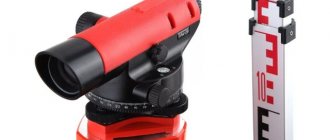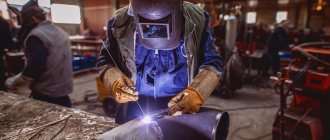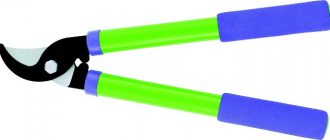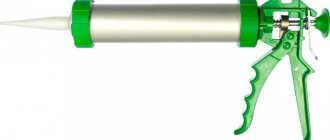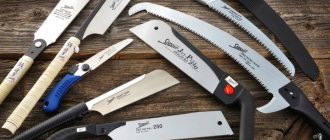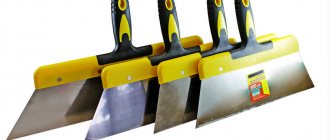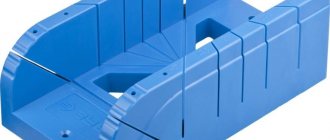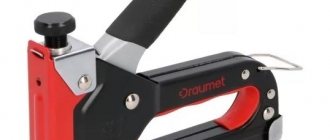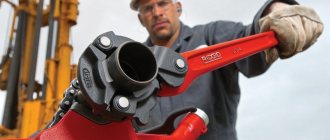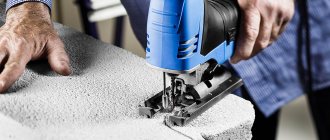Tool Features
What a vernier tool has in common are two mandatory design elements:
- A rod (or metal rod) with a main (fixed) measuring scale: gives measurement readings in millimeters or inches.
- Movable frame (vernier or vernier) with an auxiliary scale: allows you to determine fractional fractions of a millimeter or inch when taking measurements.
In terms of measurement accuracy, a caliper tool is second only to a micrometer. In the first case, when taking measurements we obtain an accuracy of up to tenths or hundredths of a millimeter (depending on the model of the device), a micrometer gives an accuracy of readings of up to a thousandth of a millimeter.
There are several main types of such devices available:
- Vernier calipers - will allow you not only to measure the parameters of products or the depth of holes, but also to apply markings on the surface.
- Gauge gauges - for transferring dimensions from the drawing to the workpiece and drawing parallel marking lines.
- Vernier depth gauges - for measuring the depth of grooves and holes.
- Vernier gauges - for measuring the parameters of gear racks or gear teeth.
Types of caliper designs and their markings
Along with the simplest mechanical model, the structure of which is discussed above, there are others. They can be divided into 4 main types, having 8 standard sizes. Their designs, as well as their purpose, have some differences. In addition to the double-sided caliper ShTs-1 discussed above, there is a one-sided version ShTsT-1. It has jaws on only one side and a ruler for measuring depths. Although it has a mechanical device, like ShTs-1, the material for its manufacture is hard, high-alloy steel. Such a tool helps to determine the external linear dimensions and depth of holes during abrasive action on the object being measured.
The instrument, called ShTs-2, is equipped with a double-sided design, but the jaws for measuring internal and external surfaces are combined, and have, respectively, flat surfaces on the inside and cylindrical surfaces on the outside. Opposite them are jaws of the same size for measuring external dimensions, which have sharpened edges. This allows you to not only measure, but also mark on the surface of the part being measured. In addition, this model has an auxiliary micrometer feed frame, which allows you to take readings with great accuracy.
The ShTs-3 caliper differs from the previous model only in its one-sided design. Its pair of jaws are designed to measure both internal and external dimensions. This model is designed to measure the largest sizes, so it is also quite large. And the larger the size of the measuring device, the greater the resulting measurement error. Therefore, in addition to the designs described above, calipers are divided according to the indicators with which readings are taken.
According to this principle, they are divided into vernier ones, in which the readings are calculated independently based on the movement of the frame, into dial and digital ones. Dials marked ShTsK use the same mechanical principle. On the frame there is a digital scale connected to the rod by a gear transmission. Whole millimeters are read by the position of the edge of the frame, and their fractions are narrower by the dial. Such a caliper has a higher accuracy class than a vernier caliper and can be up to 0.01 mm. However, it is very vulnerable to mechanical damage and contamination of the rack from the parts being measured.
History of the instrument
The first to be invented was the caliper. You should not trust German terms that are consonant with this tool: in translation, “stangenzirkel” is a large compass for drawing arcs of large radius and circles of large diameter. In German, calipers are called "messschieber" - "sliding meter".
The prototype of the first caliper was wooden, and appeared at the beginning of the 17th century. But in the form and design - with a vernier - in which we know the device, the caliper appeared at the end of the 18th century in England, and immediately - in metal. The author of the first vernier was the mathematician Pedro Nuniz - he developed navigation instruments for the fleet, but an earlier model of a moving frame with a scale was invented by the French mathematician Pierre Vernier in the 30s of the 16th century (therefore, the second name of the vernier is vernier).
Almost simultaneously, with a difference of 5-7 years, other beam tools appeared: technology and technical progress developed, new technologies appeared.
An example of the influence of new technologies on such devices is the electronic reading device, or the marking of calipers over 500 mm not from zero. In the second case, this is due to the possibility of applying markings using a laser: the outdated - mechanical - method of applying markings could not provide the necessary accuracy to measuring instruments.
Types and features of tools
We offer the main types of calipers GOST 166-89:
- Type-1 – models ШЦ-1, ШЦЦ-1 (with digital reading), ШЦК (with a circular reading device).
- Type-2 – models ШЦ-2, ШЦЦ-2.
- Type-3 – models ШЦ-3, ШЦЦ-3.
- Models with carbide jaws – ShTsT (ShTsT-1, ShTsT-2, ShTsT-3).
Type 1 . The tool has a double-sided arrangement of jaws: some are used for measuring external parameters, the second are used for measuring internal parameters and performing marking work. Models with an upper limit of 125 mm and above are equipped with depth gauges for measuring recessed ledges, grooves and holes.
In addition to taking measurements of large elements (parts), this type of calipers is convenient for measuring thread pitch: their small jaws have the profile and shape of sharpened blades.
Type 2. Like Type-1 models, these calipers have two pairs of combined jaws - with flat internal surfaces and cylindrical external ones. But this type of tool is not equipped with a depth gauge.
Type 3. Exclusively measuring tool - equipped with only one pair of jaws. As a rule, such a tool is used when measuring large parts (blanks, parts elements)
SHCT models. These are the same SHTs models, but the difference is in the design of the jaws: carbide plates are installed on them. This allows for repair of the working surfaces of calipers and further use of the tool. They are used for taking measurements when there is a constant abrasive effect on the working surfaces (jaws) of the caliper.
Details
What to look for when choosing
Materials
What types of calipers exist based on materials of manufacture? Metal calipers are usually made from stainless and carbon steel, as well as from low-alloy tool steels KhVG and 9ХС. Stainless steel tools are classics, but in the production of modern calipers, composites are also used, for example, based on carbon fiber and polymer resin.
Dimensions
Typical dimensions of a classic caliper:
- Sponge size for external measurements is from 3.5 to 30 cm.
- The size of the sponge for taking internal measurements is from 0.6 to 2.2 cm.
- Measuring range up to 200 cm.
- Vernier size is from 0.9 to 3.9 cm.
- Weight (will depend on size and material) from 0.2 to 8.9 kg.
Models with a measurement range of up to 5 meters can weigh more than 35 kg.
GOST
These current GOSTs regulate both the inspection and production of tools (calipers):
- GOST 8.113-85 - helps determine the inspection procedure.
- GOST 166-89 - helps determine technical conditions.
Now a little about accuracy.
Accuracy
Vernier-type calipers are characterized by several accuracy classes:
- First class - in it the error will be 0.005 cm (a twentieth of a millimeter).
- Second class - the error will be 0.01 cm (tenth of a millimeter).
For high-frequency measurements, a completely different instrument is used, called a micrometer. To clearly show what the accuracy class will influence, it is enough to assume that the diameter of certain drills should be determined without markings. A caliper of the second accuracy class will make it possible to select drills with a diameter of 0.67 and 0.68 cm, and of the first class and 0.675 cm. For electronic type tools, the error can be 0.001 cm.
Verification
In the process of performing work with a caliper, a violation of the settings, various deformations of individual elements and simple wear may be visible. All this will affect the accuracy of the measurements, which can be distorted by adhering dirt, grease, and metal filings that cover the instrument with a magnetized layer.
Please note that every owner of a caliper needs to handle the tool with care and keep the tool clean.
To avoid various distortions in the measurement results, the instrument should be checked every year. To do this, it will be enough to contact a special service center for repair and setup. Based on the verification results, a special certificate is issued. At home, you can perform a simple check of the correctness of the readings if you press the jaws of the bar all the way. In this case, the zero strokes must necessarily coincide. Let's look at other types of calipers.
Marking
There are these types of markings:
- ШЦ-1 – makes it possible to determine the internal and external dimensions due to two pairs of jaws. The depth of the holes will be determined using an appropriate ruler.
- ШЦ-IC - readings will be simplified due to the arrow head, and its gears will be engaged with a rack that is installed in the rods.
- ShTsT-I – one-sided jaws have a hard alloy coating. All are used in highly abrasive conditions.
- ШЦК - used where high measurement accuracy is not needed, because readings are taken from a circular scale, and it is based on a spring mechanism.
- ШЦ-II – a frame feeding mechanism has been added to the double-sided jaws, and this allows marking.
- ШЦ-III – a characteristic feature is one-sided jaws, as well as large sizes. It cannot measure depth.
- ШЦЦ – readings are taken using a digital scale.
Next, let's take a closer look at the types of calipers.
Types of calipers and cost
Calipers can be divided into the following main types.
Analog
The counting can be carried out by a vernier, and its other name is “vernier”. Cost from 450 rubles.
Switch
No calculations required, easier to use because the measurement results will be displayed on the dial with a circular scale. Cost from 1800 rubles.
Digital
With a small display, and digital measurements are displayed on it. Has high accuracy. Another name would be electronic. Cost from 780 rubles for the simplest models. Moreover, the booms can be with a depth gauge (type T-I or I) or without it (type II and III).
Precision calipers are a general name for models that have an increased level of measurement accuracy. By the way, if a monoblock instrument (fixed lips are not attached to the bar, but are an integral part of it) is capable of giving the most accurate readings. There are tasks for which a standard tool simply cannot cope.
Special calipers
There are striking examples of special models.
Marking
With carbide sharpened jaws and a special compass mechanism. In addition to taking measurements, it is possible to draw arcs on the carbide material using the jaws themselves. A caliper for marking will be similar to options without a compass-type mechanism with jaws based on hard alloys. Cost from 2600 rubles.
ШЦЦД (for brake discs)
The types of calipers and their purposes differ from each other. Designs with elongated one-sided jaws for external measurements, which have teeth on the working surface to improve measurement accuracy. There are options that allow you to determine the thickness of car brakes and discs without having to remove the wheels. The cost of the simplest week is approximately 1,000 rubles.
Traveler
It is suitable for measuring rail tracks. The cost of the tool is from 20,000 rubles. By the way, analogues of calipers include the following measuring instruments, which are described below.
Vernier gauge
This tool is needed to measure the teeth of racks and gears with an accuracy of 0.002 cm.
Vernier depth gauge
Such a tool is needed to measure the depth, height of a blind hole, protrusions, and grooves.
Shtangenreysmas
This tool allows you to measure heights without special skills and perform vertical markings of parts with an accuracy of 0.005 cm.
PAN DEPTH GAUGES
A vernier depth gauge is a type of vernier tool. Its purpose is to obtain data on depth measurements in parts - grooves, grooves, holes, ledges.
Features and types of instruments
Externally, the device resembles a caliper - there is a metal frame and a rod. But there are no sponges: the ends of the base and the rod of the device act as working (measuring) elements. The standard measurement accuracy of models with a mechanical vernier is 0.1 mm (like a caliper), but more accurate models are with instruments with a circular (0.02 mm) and digital (0.01 mm) scale.
The principle of operation of the instrument is simple: the working part of the rod is inserted into the recess to be measured, and the position fixed by the frame with the base (lowered all the way) gives readings. If it is necessary to take measurements on complex surfaces, special tips and pegs are used for the rod.
The type of depth gauge according to GOST 162-90 is determined by the reading method:
- SHG – model with vernier reading.
- ShGK – model with a circular scale.
- SHGTs – digital (electronic) model.
The type of instrument, measurement range, discrete step (division value) is determined by the markings applied to the product.
The tool is used in metalworking (machining of workpieces), in mechanical engineering and construction, during repair work (construction, auto repair shops, equipment) and other areas where accurate measurements are necessary.
Specifications.
Vernier calipers are made of carbon or stainless steel, with a vernier reading value of 0.05 mm and 0.1 mm, accuracy classes 1 and 2 with a metric scale. The hardness of the measuring surfaces of tool and structural steel is at least 51.5 HRC. The caliper is equipped with a locking screw.
Specifications are shown in Table 1.
Table 1.
| The name of indicators | ШЦ-II-250-0.05 | ШЦ-II-250-0.1-2 |
| 2.1. Measuring range, mm | 0-250 | 0-250 |
| 2.2. Vernier reading value, mm | 0,05 | 0,1 |
| 2.3. Caliper accuracy class | — | 2 |
| 2.4. Measurement error, mm | ±0,05 | ±0,1 |
| 2.5. Overall dimensions, mm | 370×125×10 | 370×125×10 |
| 2.6. Weight, kg, no more | 0,425 | 0,425 |
LENGTH GRAY MASSES
A height gauge is a simple and accurate tool that is used when measuring the height of a part, the depth of holes, the relative position of the surfaces of parts on one body, and carrying out marking operations. The device can be used with an additional connectable unit on which measuring heads are installed with parallel or perpendicular placement relative to the plane of the base.
Features and types of instruments
The device has an external similarity to most representatives of the category of caliper tools. Its design in accordance with GOST 164-90 includes the following elements:
- Massive base.
- Vertical rod with a millimeter main scale (ruler).
- Main frame.
- Vernier with additional (micrometric) scale.
- Measuring foot.
- Auxiliary elements - frame screws and nuts, a holder for interchangeable devices, a scriber, a micrometer frame.
The tool allows you to carry out both horizontal and vertical measurements, and when installing an additional unit, oblique measurements.
The gauge is used in metalwork and turning workshops: it is used to determine the linear geometric dimensions of parts, the depths of holes and grooves, and to mark workpieces during assembly or repair. It is used in various industries - metalworking, mechanical engineering, automobile and shipbuilding.
The classification of devices is carried out according to several indicators:
- According to design features: ShR - vernier, ShRK - with a circular readout scale, ShRTs - with digital (electronic) readout.
- According to the maximum measured height (length) of parts (maximum indicator - 2500 mm).
- By accuracy class.
- For digital models - by discrete step.
PANEL TOOTH GAUGERS
A caliper is a device that resembles a combination of a conventional caliper and a depth gauge. A depth gauge allows you to set the measurement height (the thickness of gear teeth varies depending on the height), and a caliper allows you to measure the thickness of a tooth at a certain height (at the measuring point).
The main area of use is mechanical engineering: with the help of the device, complex mechanisms (assemblies) that have gears - gears or racks - are manufactured or repaired.
Tool Features
Structurally, a vernier gauge consists of a rod and a ruler: they move in grooves with a perpendicular (90° angle) placement. The frame is equipped with verniers, a micro-transmission is responsible for positioning the rod and frame, and the elements are secured with locking screws. The measuring scales on the ruler and rod are placed in small recessed surfaces to prevent premature wear.
We offer models with a vernier (vertical and horizontal scale with a division value of 0.5 mm, with a vernier reading within 0.02 mm) or an electronic readout. The tool is made of tool steel with a matte (anti-reflective) chrome finish. Measuring surfaces have a carbide coating.
The catalog presents models designed for taking measurements on parts with different tooth pitches and different measurement limits. You can select the tool yourself or seek help from our consultant: this will simplify and speed up the correct selection of the device in accordance with your requirements.
How to choose a good tool
The main advantages of a caliper are the accuracy of measurements. For this reason, a high-quality tool must be made of durable material, have easily visible markings and withstand heavy use. Stainless steel tools with engraved markings are popular among experienced craftsmen due to their high resistance to durability and corrosion.
The main principles of choice will be the following:
- Length - it will determine the measurement range. It should be selected depending on the tasks. For everyday use, a tool measuring 12.5 cm will be sufficient, but for building a house, for example, you will need a boom 5 meters long.
- Measurement step - roughly speaking, the measurement result will be much more accurate for those models that have the smallest distance between adjacent scale divisions.
- Price – you shouldn’t buy an expensive model for occasional home use, but a good caliper won’t come cheap. Craftsmen for whom this instrument is the main one for measurements should look towards proven German, Japanese and Swiss models. High-quality tools, especially electronic ones, are very expensive, and it is enough to buy them once, because they will last a lifetime. The frequency of use should be based on the price of the tool.
Before purchasing a bar, make sure that there are no gaps between the fixed and moving parts, and that the zero marks of both scales match when the jaws are closed.

